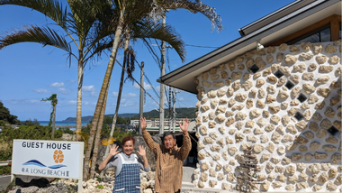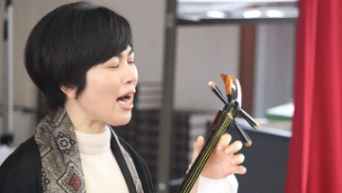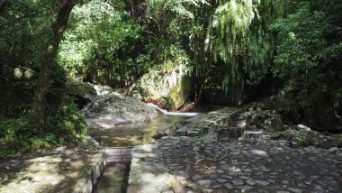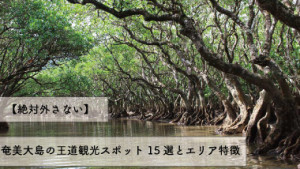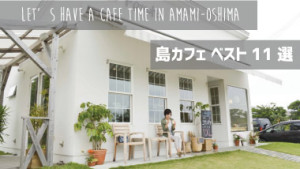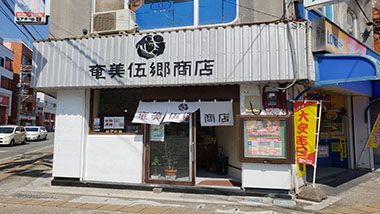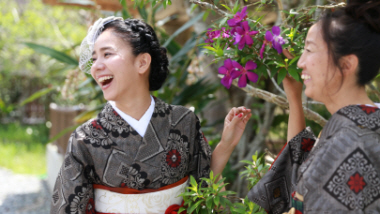The Sounds of Amami~奄美を彩る音~
島コト
2019/03/13
Rosemary White
*日本語バージョンは英語の記事の後にあります*
The moment you arrive on Amami Oshima, you immediately feel the unique and distinct atmosphere of the island; the sights, the smells, the sounds, and more combine to make up the Amami Oshima experience.
Even the slightest sound can provoke a feeling that something about your surroundings is fundamentally different. Amami Oshima hosts many striking sounds that are different even from the rest of Japan, so in this article I’d like to introduce the various sounds that you encounter while on Amami Oshima.
The ‘Oshima-zemi’
Various interesting insects live on Amami due to the subtropical climate, but the elusive ‘Oshima-zemi’ stands out from the others. The ‘Oshima-zemi’ is a kind of cicada that only lives on the Ryukyu Islands from Amami Oshima down to the main island of Okinawa.
Of those travelling to Amami for the first time, many don’t even know the ‘Oshima-zemi’ exists; when people hear the sound it makes, most think it is a birdcall!
However, it is not a birdcall at all, it is the ‘Oshima-zemi’ cicada, whose song builds a chorus of sound surrounding the dense forests that cover the mountains and hills of Amami Oshima in the summers.
These cicadas don’t usually go far into the more populated areas on Amami, but maybe you’ll get a chance to see one on your visit here! You’ll definitely hear them if you visit in the summer!
Check out the following link for a video of the ‘Oshima-zemi’ and its sound!
https://www.youtube.com/watch?v=Cz9AS9qxfHk
‘Yamori’
There are 3 different types of common geckoes that can be found just about everywhere on Amami Oshima, even inside buildings and houses!
These are generally called ‘yamori,’ derived from the kanji characters for ‘house protector.’ The people of Amami Oshima consider these geckoes to be guardians of the home, especially because they eat insects and other pests that enter buildings, so they live together peacefully.
On summer nights, one type of ‘yamori’ actually has a specific sound it makes; this is known in English as the common house gecko (Hemidactylus frenatus). It makes a kind of chirping noise, almost like the clicking sound that people make with horses.
Check out the sound it makes on this website here!
The Language of Amami Oshima
On Amami Oshima, the local languages (known as ‘shima-guchi’ on Amami) are actually different from standard Japanese and other dialects. There are two separate languages on Amami as well; there is the Northern Amami-Oshima language and the Southern Amami-Oshima language, which are related to Japanese and the language spoken in Okinawa, but are still quite different.
However, very few people actually speak these languages fluently. Most adult islanders speak a mix of standard Japanese with a variation of the Amami dialect, and the Amami languages are essentially a foreign language to many islanders (especially younger people).
There are various efforts to continue education of these Amami languages to keep them from completely dying out, including educational videos and radio programs (to be continued in the next section).
Take a look at the following two videos and compare for yourself! The first video is in standard Japanese, and the second one is in the southern Amami Language.
Japanese: https://www.youtube.com/watch?v=R19wUzJV7pU
Southern Amami-Oshima: https://www.youtube.com/watch?v=zTGhvsDjehA
While walking around the streets on Amami Oshima, take a minute to listen to the conversations of those around you, especially those who are between older people. Chances are you’ll hear a mix of the Amami dialect and the Amami language!
Local Radio Stations
The local radio stations of Amami Oshima are not only a main channel for people to connect on the island, but they also hold special programs to further spread the unique culture of Amami.
Many mix the local dialect with Japanese in their broadcasts, and host educational shows about the Amami languages with the aim of increasing speakers of these languages. They play Amami local folksongs (‘shima-uta’) and other popular local artists, as well as provide essential information during emergencies.
In Amami City, the Amami FM radio station is played in the streets, as well as in many shops and restaurants. While walking through the shopping area you could hear classic Japanese Enka songs, then a ‘shima-uta’ folksong sung in the Amami language, and then a local hip-hop duo. The variety and incorporation of the Amami community creates a very interesting and engaging atmosphere.
You can listen to Amami FM live broadcasts online (this page gives you instructions) or on the ListenRadio app (however it is all in Japanese), and if you visit Amami you will surely encounter the broadcasts of the various stations!
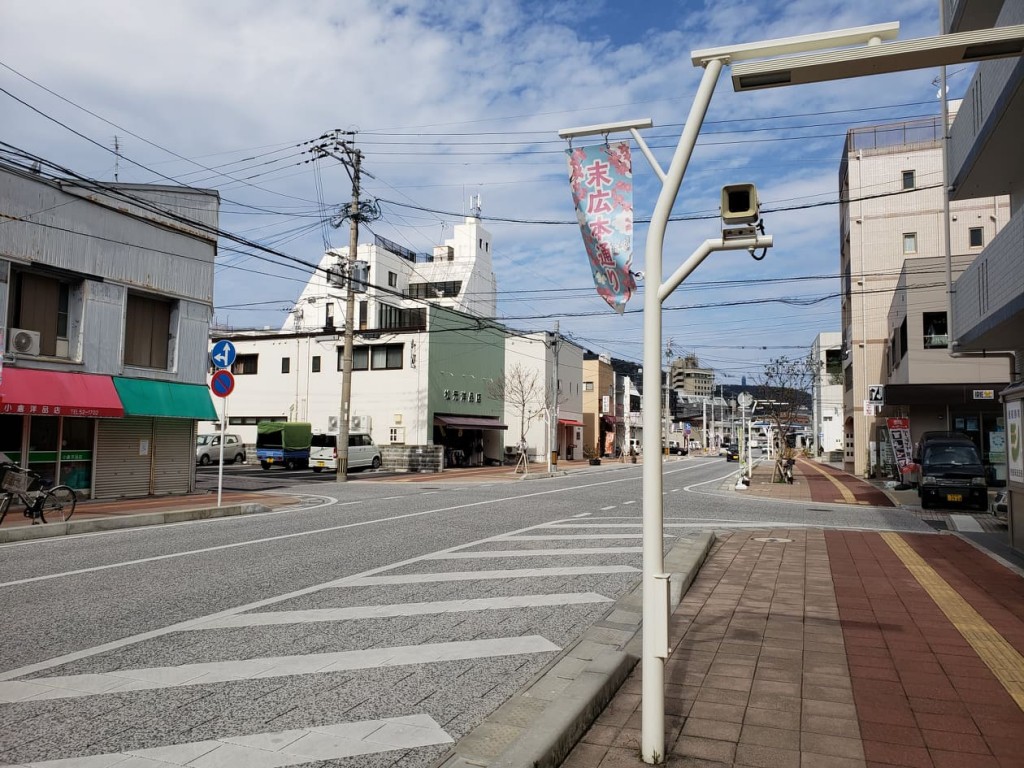
A speaker on the street, which the Amami FM programs are broadcast from
‘Shima-uta’ (local folksongs)
The people of Amami Oshima are very proud of their musical heritage that distinguishes them from the rest of Japan, and even the world. ‘Shima-uta’ songs are characterized by a simple yet refined ‘shamisen’ (three-stringed Japanese guitar) tune combined with a particular high-range singing style that is created by keeping vocal chords tight while singing, and occasionally a beat played on the ‘chijin’ drum.
‘Shima-uta’ are songs created to tell of the daily lives of the islanders, conveying everything from hardships, to traditions, and love stories.
However, the ‘shima-uta’ style of singing used to be a way to interact with one another; people would hold gatherings and casually sing improvised lyrics to someone playing the ‘shamisen’ (paired with ample drinking of the Amami kokuto shochu liquor that is made with brown sugar, of course).
The ‘shima-uta’ from Amami Oshima have been passed down through word of mouth in communities for many years, and thanks to modern technology they can be preserved for many more years to come.
Check out these popular ‘shima-uta’ artists, and share this beautiful art form!
Anna Sato, Tomoki Sato, Shingo Maeyama, Chitose Hajime
There are also various restaurants that have live ‘shima-uta’ performances, so keep an eye out for those as well!
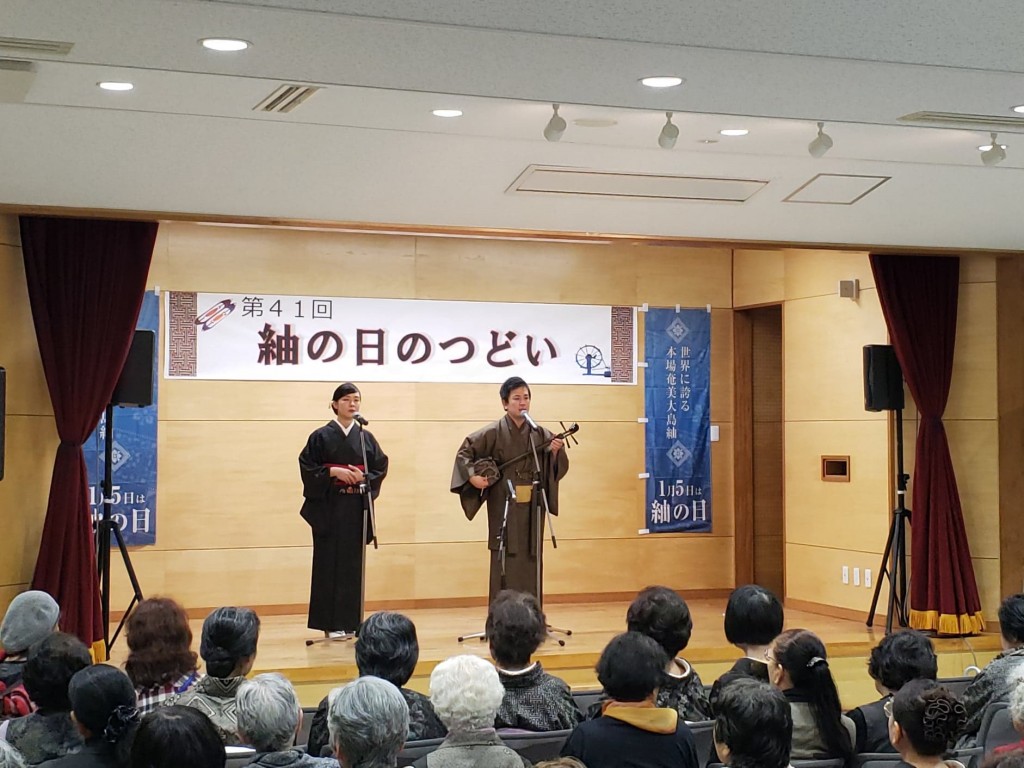
Shingo Maeyama performing at a local festival, accompanied by Juri Mukai
Amami Oshima is truly a one-of-a-kind island, and the sounds that one encounters on the island is only a small part of that. Come to Amami and experience all of its charm for yourself!
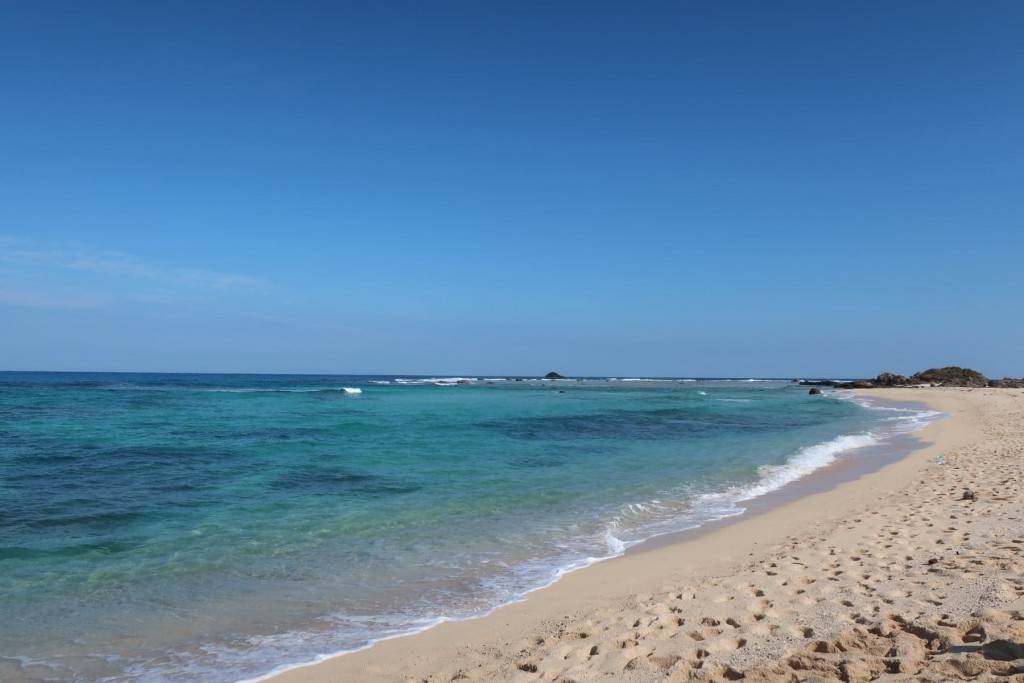
Tomori Beach, Kasari area of Amami City
———————————————————日本語バージョン——————————————————–
奄美大島の「音」
奄美大島に到着したとたんに、すぐ島のユニークな雰囲気に気付きます。島の景色、匂い、音などを含めて、奄美大島ならではの経験です。
少ししか聞こえない音だけで周囲の何かが違うという感じを生み出します。奄美大島には日本の中でも特別なたくさんの「音」があります。この記事では奄美大島の様々な「音」を紹介したいと思います。
オオシマゼミ
奄美大島の亜熱帯気候のおかげで色々な昆虫がいますが、あまり見かけない「オオシマゼミ」が特に面白いのです。「オオシマゼミ」は琉球諸島の奄美大島から沖縄本島までの島に生きている種類のセミです。
初奄美旅の人は「オオシマゼミ」の存在を知らない人が多いと思います。「オオシマゼミ」の音を聞いたら、鳥の鳴き声と間違ってしまうことがよくあります!
しかし、これは鳥の鳴き声ではなく、「オオシマゼミ」なのです。夏の間、「オオシマゼミ」の鳴き声はコーラスのように、山の上にある森から大きな「音」を出します。
人が多いところにあまり行かないセミですが、もし運が良ければ次の奄美旅に見かけるかもしれません!夏に来たらきっと聞こえますよ!
このリンクを押したら、「オオシマゼミ」の動画が見られます!
https://www.youtube.com/watch?v=Cz9AS9qxfHk
ヤモリ
奄美大島の3種のヤモリはどこでも見つけられます。建物や家のなかにも!
漢字の書き方は「家守」で、奄美大島でヤモリが「家の守り神」という風に言われているのです。ヤモリが家に入ってしまった虫などを食べてくれるので、人間と共に生きています。
夏の夜に、1種のヤモリが鳴くのですよ。これは「ホウグロヤモリ」で、「チッチッチッ」や「ケッケッケッ」とのような鳴き声がします。
このウェッサイトにて「ホウグロヤモリ」の鳴き声が聞けますよ!
奄美大島方言
奄美大島では、地元の人が普段しゃべっている言葉は島口と呼ばれていて、特別な特徴が色々あります。奄美の方言は二つに分けられ、奄美大島北部方言と南部方言があります。
しかし、この方言を流暢に話せる人が非常に少ないです。一般の大人は標準語と奄美の方言を交ぜたしゃべり方をしますが、多くの島人(特に若者)にとって奄美の方言はまるで外国語のような言葉です。
奄美の方言を残していくために様々な活躍が実施されています。島口教室のビデオや、島口が学べるラジオの放送番組などもあります。
下記のビデオを見て、自分で比較できます!一つ目のビデオは標準語のナレーションがあって、二つ目のビデオは奄美大島南部方言のナレーションがあります。
標準語バージョン:https://www.youtube.com/watch?v=R19wUzJV7pU
奄美大島南部方言:https://www.youtube.com/watch?v=zTGhvsDjehA
地元のラジオ番組
奄美大島のラジオ局は人との繋がりができるだけでなく、奄美のユニークな文化を広げていけるのです。
多数のラジオ番組が島口と交ぜた話し方で放送したりして、方言が話せる人が増えるように島口教育番組も実施しています。そして、奄美の「島唄」や地元のアーティストの音楽も放送したり、災害の時に緊急情報も流したりしています。
奄美市で、あまみエフエムディ!ウェイブというラジオ局が、道や多くのお店とレストランで放送されています。商店街を歩きながらスピーカーから演歌の歌が流れて、そして奄美の方言で歌った島唄の曲、その次に地元のヒップホップアーティストの曲が流れてくることが普通なのです。このように歌の多様性と奄美のコミュニティーに関しての放送を含めて、とても面白くて楽しい雰囲気を生み出します。
このウェブサイトとListenRadioというスマホアプリであまみエフエムディ!ウェイブの放送も聞けるし、奄美に来たら様々なラジオ局の放送も聞けます!

あまみエフエムディ!ウェイブの放送がこの道でのスピーカーから流します!
奄美の島唄
奄美の人は日本とも世界とも違う独特な島唄の文化と伝統をとても誇りに思っています。「島唄」の特徴は、三味線のメロディーに合わせた高音の歌い方、そしてたまに「チジン」という太鼓が刻むビートです。
島唄は島人の日常生活を表すように作られた歌で、島人の苦労や伝統、恋愛物語について語っている歌です。
しかし、元々島唄は周りの人と一緒に楽しむことでした。近所の人で集まって、だれかが三味線を弾きながらその場で考えて歌いだした歌詞で歌っていました(もちろん奄美の黒糖焼酎も飲みながら!)
奄美の島唄は長年集落ごとで伝えられてきたものですが、現代の技術とテクノロジーのおかげでこれからももっと広がっていけます。
ぜひ下記の島唄者を聞いてみて、この珍しくて美しい音楽を経験してみてください!
そして、生で島唄聞けるレストランが色々あるので、ぜひ行ってみてください!

前山真吾が向珠理と一緒に「紬の日のつどい」という祭でのライブ
奄美大島は本当に独特な島で、奄美で触れる「音」はその一つです。奄美大島に来てみて、奄美だけの魅力を肌で体験してください!

奄美市の笠利にあるともり海岸
この記事を書いたフォトライター
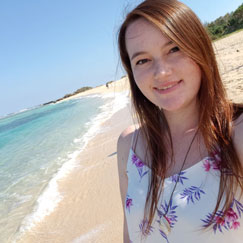
Rosemary White
Born and raised in New Mexico, U.S.A, I have worked as a Coordinator for International Relations for Amami City as of August, 2018. I translate materials such as Amamikke articles as well as write my own, and I run the Amami Island Info facebook, insta and twitter accounts. Amami foodie and tour guide in the making. アメリカのニューメキシコ州生まれ育ち、2018の8月から奄美市の国際交流員(CIR)として奄美大島に来島。観光パンフレットやあまみっけの記事の翻訳、SNS情報発信。自然探検、美食家。
